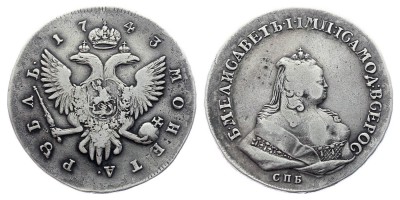In the middle of the XVIII century, the Germanic states did not have a single monetary device. Several kingdoms, dukedoms, free cities and provinces minted money for themselves. The formation of general financial relations took place after the unification of separate states into an empire.
In 1743, the German mints put into circulation 1 silver thaler and copper coins:
- 4 pfennig;
- 6 pfennigov;
- 1 geller.
Pfennig, or pfennings - sources admit such spelling variations and pronunciation of the word, differ in their design. On the obverse of the 4 pfennig coin, the Münster series, is depicted the monogram of Bishop Clemens August, with a crown. On the reverse: three lines of inscriptions, where the denomination and year of release are indicated.
On the obverse of the 6 pfennig coin, the Paderborn bishopric: nominal, year of issue, name of the country. On the back: on the coat of arms of the Teutonic Order is located the crowned heraldic shield of Clemens August, in the form of a circle, and the heraldic symbols of Bavaria and the Palatinate.
Geller in 1743 minted the Kassel Mint of the Kingdom of Westphalia. The obverse of a copper coin is drawn up in inscriptions, in the form of face value and date of coinage. On the reverse:
the monogram of King Frederick I of Sweden - "FR", with a crown at the top. There are no legends on the coin. Such banknotes are called "dumb coins."
In the thirteenth century, the Hellers ousted the pfennig. This was due to the fact that gellers are not subjected to damage - unauthorized understating of weight and content of the noble metal. At this time, geller minted from silver. The popularity is also increasing because there is no renovation with gellers - the exchange of the newly printed coins for the old ones at the undervalued rate. Residents lose up to 25% on this operation and mincing.
When mincing and reducing the weight, the coin becomes thinner, the images on the obverse and reverse are translucent, and the reading of the coin is distorted. Geller proved to be stronger and more reliable. To prevent spoilage of coins, a mandatory indication of the mint mark is introduced. Emperor Charles IV provides for this by decree of the Holy Roman Empire. This leads to the appearance of various types of hellers, but does not protect banknotes from damage. In Germany, copper gellers are being minted instead of low-grade silver. As a bargaining chip, geller has long been used in European countries. In the 20th century, geller is printed in Austria, Hungary, Czechoslovakia, and Southeast Africa. The material used for embossing is different: nickel, copper, bronze, copper-nickel alloy.
Showing 1 to 1 of 1 (1 Pages)
 Russian
Russian English
English Deutsch
Deutsch Spanish
Spanish Português
Português


